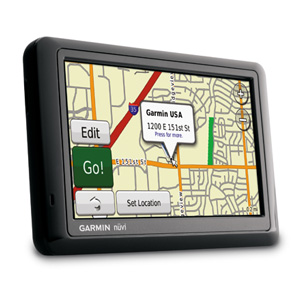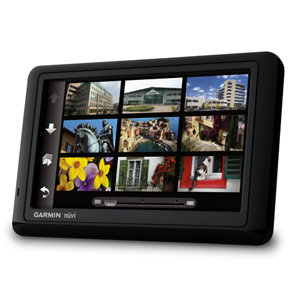Sunday, September 26, 2010
Garmin Nuvi 1490T Review
Today i will check out Garmin's newest 5-inch GPS navigator.The Nuvi 1490T's most distinguishing feature is its large 5-inch screen. Compared with the 4.3-inch units we normally see these days, the extra real estate is quite obvious.At arms length, the larger onscreen buttons are easier to hit, making light work of address entry.The unit features a glossy, black bezel with a small pinhole microphone in its lower left edge. The left side is home to a microSD card slot and on the top edge features the power/lock button.Here you'll find the Mini-USB port for charging and syncing and the unit's speaker.
The Nuvi 1490T's home screen features two large icons for the two major functions of a portable navigation device: finding a destination and browsing the map. Along the top edge of this screen is a status bar with icons for GPS signal strength, Bluetooth status, navigation mode, current time, and battery state. Touching the Bluetooth icon jumps straight to a hands-free setup screen; the navigation mode icon lets users select between automobile, pedestrian, or bicycle navigation modes; and tapping the time brings up the time settings screen.
The bottom edge of the home screen is where you can find the volume controls and the tools menu.You can select your destination using an address or by searching a preloaded database of points of interest. Address entry and search use the onscreen QWERTY keyboard, which is quite nice as far as navigation keyboards go. It doesn't feature any sort of predictive blanking of keys, but will display a list of possible completions once you've gotten a few letters punched in.
Meanwhile, the map screen is able to display 2D or 3D maps that are easy to understand and read at a glance. The top bar displays the current street or the next turn. Along the bottom edge is a back button for returning to the home screen, a configurable button that displays routing data (ETA, direction of travel, elevation, etc.) and a speed display that, when clicked, takes you to a trip computer screen.Along the map's left edge is the traffic icon that is gray when traffic data is unavailable, green when the route is all clear, or turns yellow or red when obstructions are ahead.
EcoRoute is a suite of tools and functions that the Nuvi uses to help drivers get to their destinations while using less fuel and emitting less carbon.After inputting our vehicle's city and highway fuel economy (fuel economy.gov is a good starting point) and estimated per gallon cost for fuel, the main ecoRoute function went to work, producing the EcoChallenge score.
On the map screen, a circular icon appeared containing a numerical score (from 0-99) and a leaf that changes from red to green as your score increases. Driving smoothly caused our score to increase, whereas fast starts and harsh braking resulted in lower scores. The ecoChallenge score is an easy way to estimate how efficiently the vehicle is being driven, but for even more information, you can tap the EcoChallenge icon to view a detailed scoring screen with a historical graph of the past few hours' scores and breakout averages for overall, speed, braking, and acceleration scores.
Garmin Nuvis with model numbers ending in "T" feature traffic data reception. In the case of the Nuvi 1490T, you get free lifetime FM-RDS traffic data. This data is displayed in a traffic menu as a list of incidents and on the map screen as icons and color overlays on major highways. A green highway should be all clear and a red street is probably stop-and-go, with yellow roads somewhere in between. Due to the somewhat limited resolution of FM traffic.Also, there's simply no data available for surface roads.
Traffic data is used during trip routing and to deliver more accurate estimated times of arrival (or delays). Even with no destination chosen, the Nuvi will occasionally verbally warn the driver of impending delays on the current road.Nuvi units that feature traffic receivers, such as our 1490T, carry a slightly higher MSRP than units without traffic, but don't think that Garmin is footing the monthly traffic data subscription out of the kindness of its corporate heart.The antenna for the traffic system is embedded into the 12-volt power cable, so you won't be able to receive traffic updates without first plugging in.
The Nuvi 1490T is equipped with a Bluetooth wireless connection and supports the hands-free (HFP) and phonebook access (PBAP) profiles, as well as a data connection when paired with the previously mentioned ecoRoute HD module.After inputting a four-digit PIN, the Nuvi will be recognized by your phone as a speakerphone. In the main menu, a new Phone icon appears along the bottom bar, opening up options for calling points of interest, history, and home, as well as a manual-dialing keypad. An option for voice dial opens a connection for using your phone's voice command system, if supported, to initiate calls.
Incoming calls are recognized by the Nuvi and displayed in a pop-up window along with caller ID information and options to accept or ignore the call. Call quality is passable; the Nuvi's speaker is loud and clear; but the microphone picks up almost as much road noise as spoken words, so be sure to wind those windows up and turn down the stereo before accepting or making any calls.
My Rating: 3/5
Subscribe to:
Post Comments (Atom)


No comments:
Post a Comment